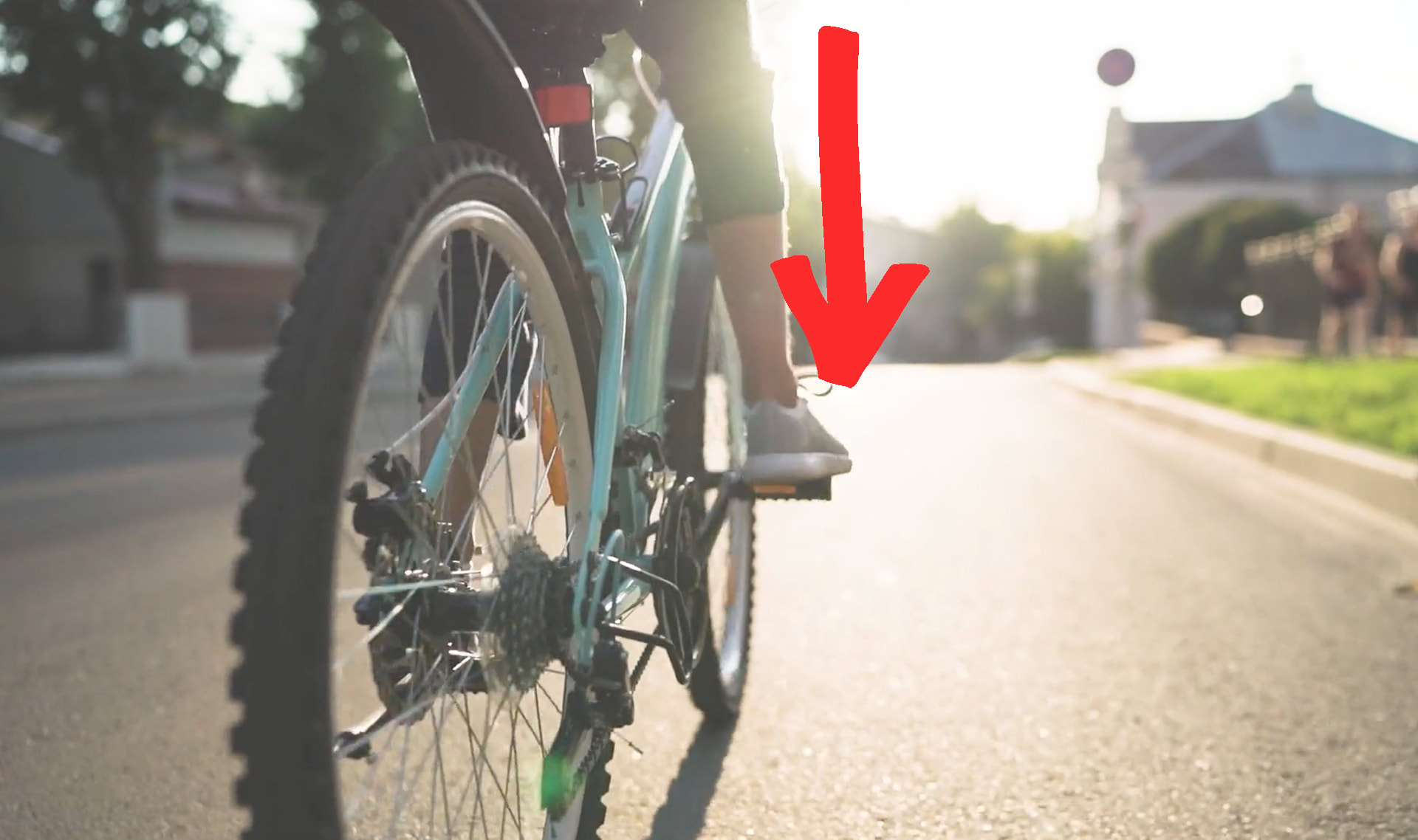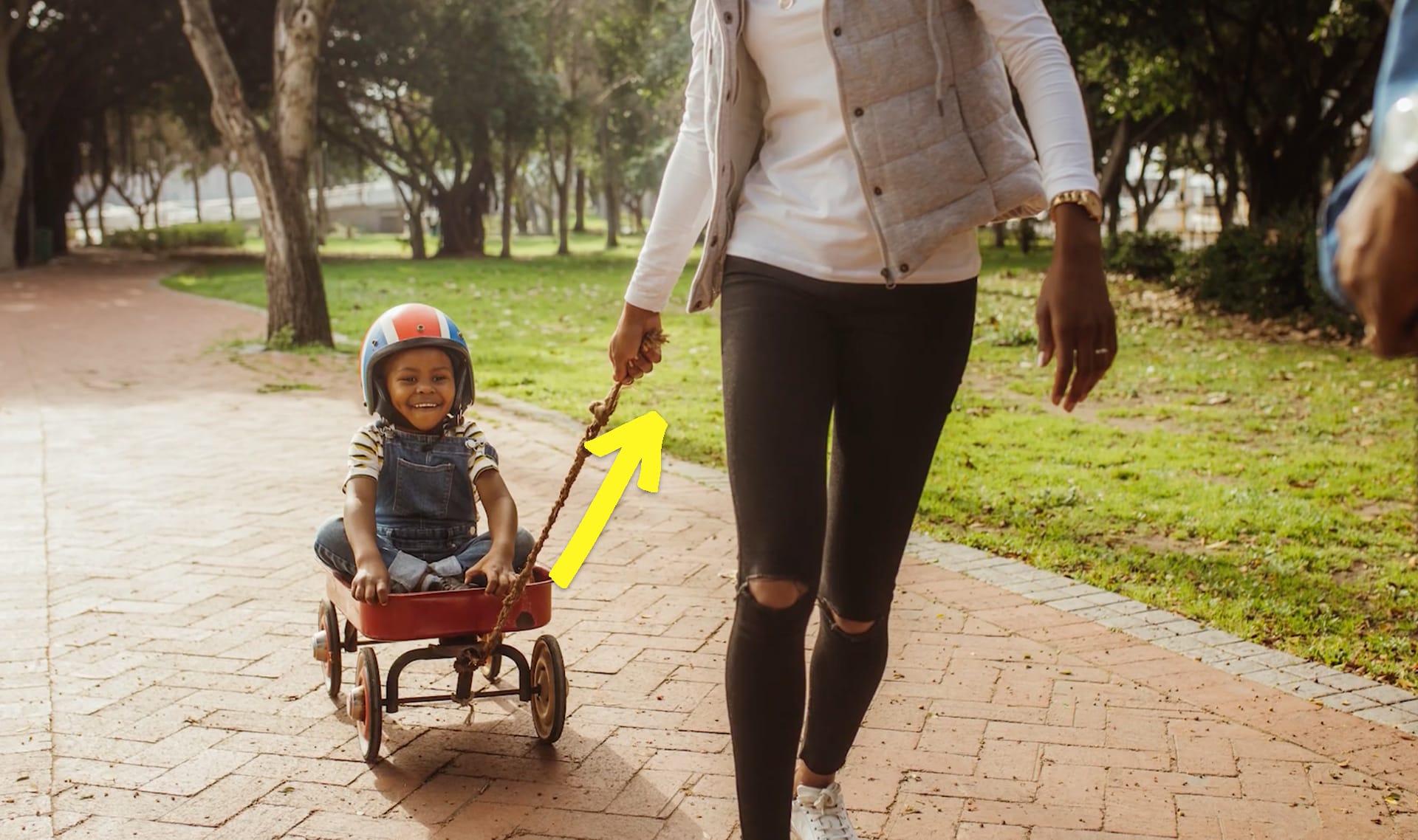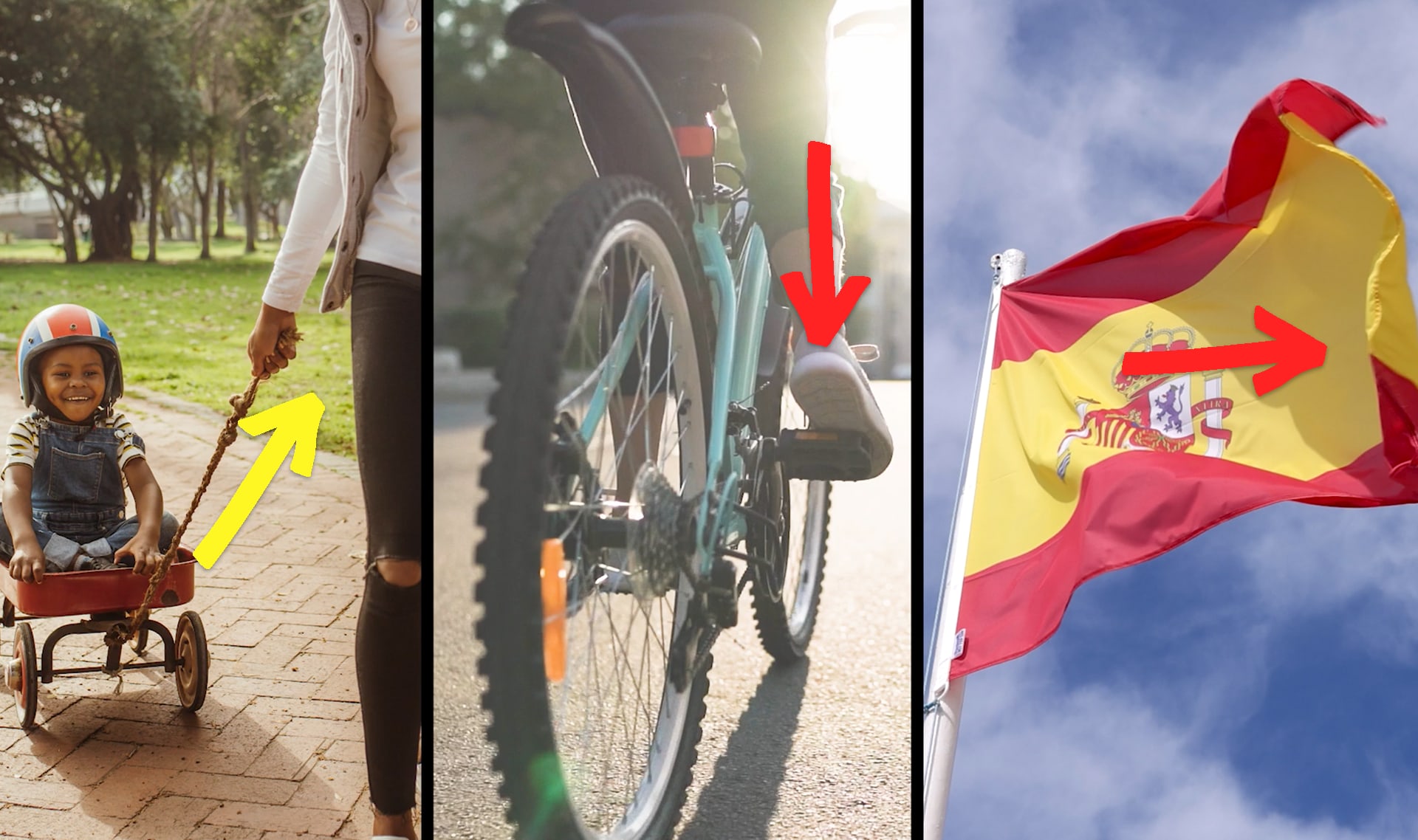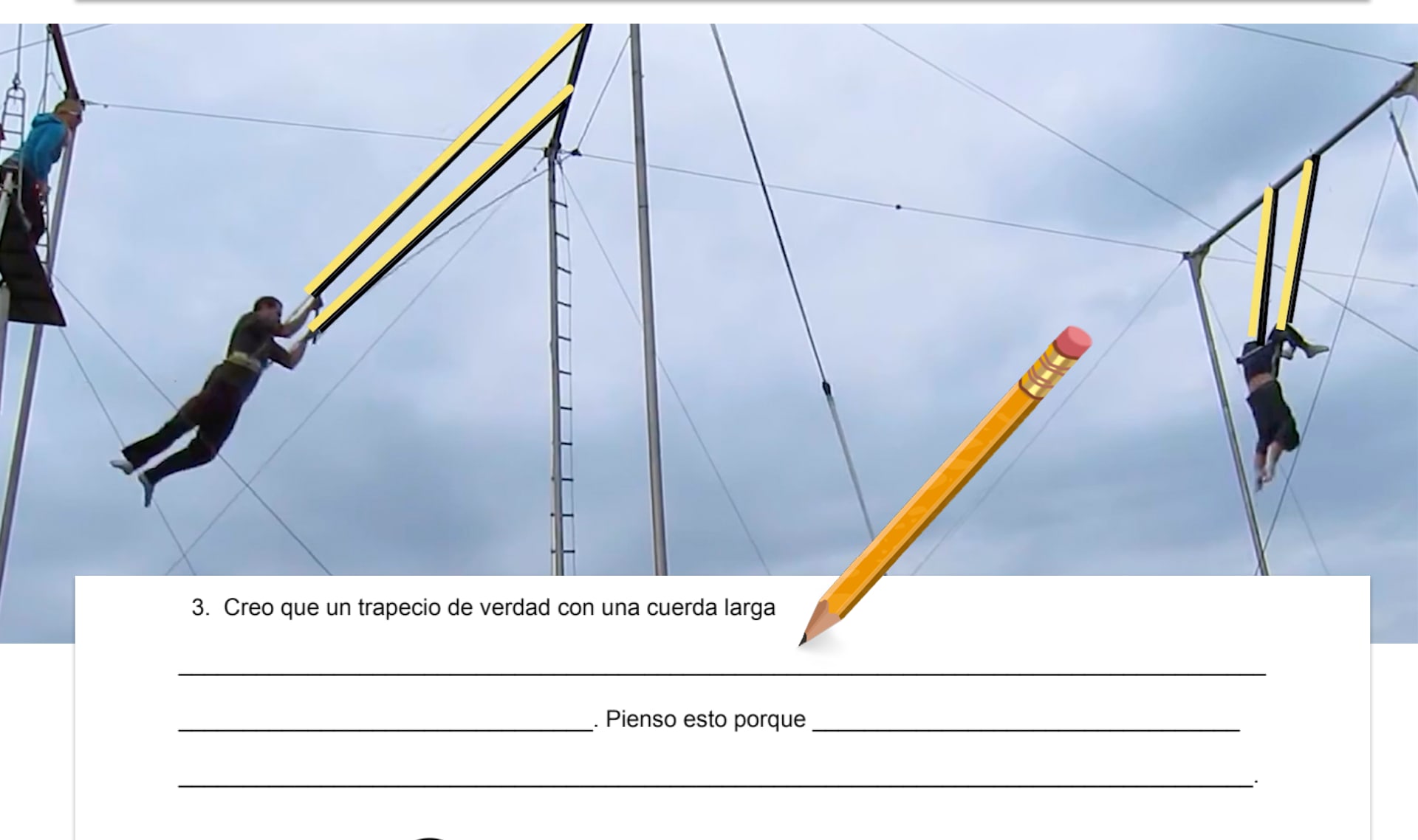
¿Qué tan alto te puedes columpiar en un trapecio?
Patterns of Motion, Gravity, & Friction
4.6
(568 reviews)
Scroll for prep

Please wait…
This video is having trouble loading. You may have lost your Internet connection.
Step 1: Click to Reload this page
Step 2: Click to
Try our other video player
Step 3: Contact your teacher if trouble persists.
Or,
dismiss this message.

Please wait…
This video is having trouble loading. You may have lost your Internet connection.
Step 1: Click to Reload this page
Step 2: Click to
Try our other video player
Step 3: Contact your teacher if trouble persists.
Or,
dismiss this message.
Conversemos:
¿En qué se parecen estas cosas? ¿Cómo son diferentes?
¿En qué se parecen estas cosas? ¿Cómo son diferentes?

Please wait…
This video is having trouble loading. You may have lost your Internet connection.
Step 1: Click to Reload this page
Step 2: Click to
Try our other video player
Step 3: Contact your teacher if trouble persists.
Or,
dismiss this message.
Conversemos:
¿Cómo supiste hacia dónde se movería el columpio?

Please wait…
This video is having trouble loading. You may have lost your Internet connection.
Step 1: Click to Reload this page
Step 2: Click to
Try our other video player
Step 3: Contact your teacher if trouble persists.
Or,
dismiss this message.
Conversemos:
¿Cómo podríamos saber cómo se moverá el trapecista en varias situaciones sin tener que practicar en un trapecio de verdad?

Please wait…
This video is having trouble loading. You may have lost your Internet connection.
Step 1: Click to Reload this page
Step 2: Click to
Try our other video player
Step 3: Contact your teacher if trouble persists.
Or,
dismiss this message.

Please wait…
This video is having trouble loading. You may have lost your Internet connection.
Step 1: Click to Reload this page
Step 2: Click to
Try our other video player
Step 3: Contact your teacher if trouble persists.
Or,
dismiss this message.
Paso
01/21
01/21
Vas a trabajar con un compañero/a. Decidan quién será el acróbata
y quién será el artista.
y quién será el artista.

Please wait…
This video is having trouble loading. You may have lost your Internet connection.
Step 1: Click to Reload this page
Step 2: Click to
Try our other video player
Step 3: Contact your teacher if trouble persists.
Or,
dismiss this message.
Paso
02/21
02/21
Obtén estos materiales.

Please wait…
This video is having trouble loading. You may have lost your Internet connection.
Step 1: Click to Reload this page
Step 2: Click to
Try our other video player
Step 3: Contact your teacher if trouble persists.
Or,
dismiss this message.
Paso
03/21
03/21
Acróbata: Pon la regla sobre tu escritorio cerca de la orilla.
Artista: Coloca un lápiz en cada lado de la regla con sus
borradores apuntando hacia ti.
Artista: Coloca un lápiz en cada lado de la regla con sus
borradores apuntando hacia ti.

Please wait…
This video is having trouble loading. You may have lost your Internet connection.
Step 1: Click to Reload this page
Step 2: Click to
Try our other video player
Step 3: Contact your teacher if trouble persists.
Or,
dismiss this message.
Paso
04/21
04/21
Acróbat:a Haz que parte del lápiz quede fuera del escritorio.
Artista: Pega un extremo del lápiz al escritorio usando una
calcomanía. Pégalo con otra calcomanía y ponle un libro pesado.
Artista: Pega un extremo del lápiz al escritorio usando una
calcomanía. Pégalo con otra calcomanía y ponle un libro pesado.

Please wait…
This video is having trouble loading. You may have lost your Internet connection.
Step 1: Click to Reload this page
Step 2: Click to
Try our other video player
Step 3: Contact your teacher if trouble persists.
Or,
dismiss this message.
Paso
05/21
05/21
Ambos: Obtén un pedazo de cuerda y una pinza sujetapapeles.
Mete la cuerda a través de las patitas de la pinza sujetapapeles.
Sosténlo de las puntas de la cuerda para que parezca un trapecio.
Mete la cuerda a través de las patitas de la pinza sujetapapeles.
Sosténlo de las puntas de la cuerda para que parezca un trapecio.

Please wait…
This video is having trouble loading. You may have lost your Internet connection.
Step 1: Click to Reload this page
Step 2: Click to
Try our other video player
Step 3: Contact your teacher if trouble persists.
Or,
dismiss this message.
Paso
06/21
06/21
Acróbata: Deja que las puntas cuelgen del lápiz.
Artista: Obtén otra pinza sujetapapeles y ponla sobre el papel
y la cuerda.
Artista: Obtén otra pinza sujetapapeles y ponla sobre el papel
y la cuerda.

Please wait…
This video is having trouble loading. You may have lost your Internet connection.
Step 1: Click to Reload this page
Step 2: Click to
Try our other video player
Step 3: Contact your teacher if trouble persists.
Or,
dismiss this message.
Paso
07/21
07/21
Ambos: Agarra un centavo y sujétalo con la pinza sujetapapeles
que está colgando.
que está colgando.

Please wait…
This video is having trouble loading. You may have lost your Internet connection.
Step 1: Click to Reload this page
Step 2: Click to
Try our other video player
Step 3: Contact your teacher if trouble persists.
Or,
dismiss this message.
Paso
08/21
08/21
Para poder ver tus pequeños trapecios mejor, siéntate en el piso.
Antes de empezar los experimentos, asegúrate de que tu modelo del
trapecio esté bien hecho.
Antes de empezar los experimentos, asegúrate de que tu modelo del
trapecio esté bien hecho.

Please wait…
This video is having trouble loading. You may have lost your Internet connection.
Step 1: Click to Reload this page
Step 2: Click to
Try our other video player
Step 3: Contact your teacher if trouble persists.
Or,
dismiss this message.
Paso
09/21
09/21
Ambos: Vamos a practicar cómo soltar el trapecio

Please wait…
This video is having trouble loading. You may have lost your Internet connection.
Step 1: Click to Reload this page
Step 2: Click to
Try our other video player
Step 3: Contact your teacher if trouble persists.
Or,
dismiss this message.
Paso
10/21
10/21
Experimento #1: Altura. Suelten el trapecio desde diferentes
alturas. Háganlo al menos una vez desde una parte alta y desde una
parte baja. ¿Qué tan alto llega el trapecio en el otro lado?
alturas. Háganlo al menos una vez desde una parte alta y desde una
parte baja. ¿Qué tan alto llega el trapecio en el otro lado?

Please wait…
This video is having trouble loading. You may have lost your Internet connection.
Step 1: Click to Reload this page
Step 2: Click to
Try our other video player
Step 3: Contact your teacher if trouble persists.
Or,
dismiss this message.
Paso
11a/21
11a/21
Conversemos.

Please wait…
This video is having trouble loading. You may have lost your Internet connection.
Step 1: Click to Reload this page
Step 2: Click to
Try our other video player
Step 3: Contact your teacher if trouble persists.
Or,
dismiss this message.
Paso
11b/21
11b/21
Esto fue lo que nosotros notamos.

Please wait…
This video is having trouble loading. You may have lost your Internet connection.
Step 1: Click to Reload this page
Step 2: Click to
Try our other video player
Step 3: Contact your teacher if trouble persists.
Or,
dismiss this message.
Paso
12/21
12/21
Experimento #2 ¿El largo de la cuerda cambia el movimiento del
trapecio? Trabaja con tu compañero/a para modificar uno de los
trapecios para que quede mucho más corto que el otro.
trapecio? Trabaja con tu compañero/a para modificar uno de los
trapecios para que quede mucho más corto que el otro.

Please wait…
This video is having trouble loading. You may have lost your Internet connection.
Step 1: Click to Reload this page
Step 2: Click to
Try our other video player
Step 3: Contact your teacher if trouble persists.
Or,
dismiss this message.
Paso
13a/21
13a/21
Ambos: Hagan observaciones sobre los dos trapecios. Pónganle
atención a los dos para notar cualquier diferencia o similitud en la
manera en que se mueven.
atención a los dos para notar cualquier diferencia o similitud en la
manera en que se mueven.

Please wait…
This video is having trouble loading. You may have lost your Internet connection.
Step 1: Click to Reload this page
Step 2: Click to
Try our other video player
Step 3: Contact your teacher if trouble persists.
Or,
dismiss this message.
Paso
13b/21
13b/21
Usemos un crónometro para contar qué tan rápido se mueve cada
trapecio. Cuando diga “empecemos”, contarás el número de veces
que se columpia hasta que diga "alto."
trapecio. Cuando diga “empecemos”, contarás el número de veces
que se columpia hasta que diga "alto."

Please wait…
This video is having trouble loading. You may have lost your Internet connection.
Step 1: Click to Reload this page
Step 2: Click to
Try our other video player
Step 3: Contact your teacher if trouble persists.
Or,
dismiss this message.
Paso
14/21
14/21
Cuenta el número de veces que tu trapecio de cuerda larga se mueve
en 10 segundos. Escribe ese número en tu hoja de trabajo.
en 10 segundos. Escribe ese número en tu hoja de trabajo.

Please wait…
This video is having trouble loading. You may have lost your Internet connection.
Step 1: Click to Reload this page
Step 2: Click to
Try our other video player
Step 3: Contact your teacher if trouble persists.
Or,
dismiss this message.
Paso
15/21
15/21
Cuenta el número de veces que tu trapecio de cuerda corta se
mueve en 10 segundos. Escribe ese número en tu hoja de trabajo.
mueve en 10 segundos. Escribe ese número en tu hoja de trabajo.

Please wait…
This video is having trouble loading. You may have lost your Internet connection.
Step 1: Click to Reload this page
Step 2: Click to
Try our other video player
Step 3: Contact your teacher if trouble persists.
Or,
dismiss this message.
Paso
16a/21
16a/21
Platica con tu compañero/a y haz una predicción.
Contesta la pregunta número 3 en tu hoja de trabajo.
Contesta la pregunta número 3 en tu hoja de trabajo.

Please wait…
This video is having trouble loading. You may have lost your Internet connection.
Step 1: Click to Reload this page
Step 2: Click to
Try our other video player
Step 3: Contact your teacher if trouble persists.
Or,
dismiss this message.
Paso
16b/21
16b/21
Esto fue lo que nosotros notamos.

Please wait…
This video is having trouble loading. You may have lost your Internet connection.
Step 1: Click to Reload this page
Step 2: Click to
Try our other video player
Step 3: Contact your teacher if trouble persists.
Or,
dismiss this message.
Paso
17/21
17/21
Experimento #3: Número de personas (o centavos). ¿El número de
centavos cambiará cómo se mueve el trapecio? Decide con tu
compañero/a qué número de centavos van a poner a prueba.
centavos cambiará cómo se mueve el trapecio? Decide con tu
compañero/a qué número de centavos van a poner a prueba.

Please wait…
This video is having trouble loading. You may have lost your Internet connection.
Step 1: Click to Reload this page
Step 2: Click to
Try our other video player
Step 3: Contact your teacher if trouble persists.
Or,
dismiss this message.
Paso
18/21
18/21
Ponle a tu trapecio la cantidad de centavos que vas a poner a prueba
primero. Cuenta cuántas veces se mueve durante un periodo de
10 segundos.
primero. Cuenta cuántas veces se mueve durante un periodo de
10 segundos.

Please wait…
This video is having trouble loading. You may have lost your Internet connection.
Step 1: Click to Reload this page
Step 2: Click to
Try our other video player
Step 3: Contact your teacher if trouble persists.
Or,
dismiss this message.
Paso
19/21
19/21
Cambia el número de centavos en tu trapecio. Cuenta cuántas veces
se mueve durante un periodo de 10 segundos.
se mueve durante un periodo de 10 segundos.

Please wait…
This video is having trouble loading. You may have lost your Internet connection.
Step 1: Click to Reload this page
Step 2: Click to
Try our other video player
Step 3: Contact your teacher if trouble persists.
Or,
dismiss this message.
Paso
20a/21
20a/21
Platica con tu compañero/a y haz una predicción.
Contesta la pregunta #6 en tu hoja de trabajo.
Contesta la pregunta #6 en tu hoja de trabajo.

Please wait…
This video is having trouble loading. You may have lost your Internet connection.
Step 1: Click to Reload this page
Step 2: Click to
Try our other video player
Step 3: Contact your teacher if trouble persists.
Or,
dismiss this message.
Paso
20b/21
20b/21
Esto fue lo que nosotros notamos.

Please wait…
This video is having trouble loading. You may have lost your Internet connection.
Step 1: Click to Reload this page
Step 2: Click to
Try our other video player
Step 3: Contact your teacher if trouble persists.
Or,
dismiss this message.
Paso
21/21
21/21
Con tu compañero/a, limpia tu área. Regresen a sus asientos y
platiquen sobre estas preguntas:
platiquen sobre estas preguntas:

Please wait…
This video is having trouble loading. You may have lost your Internet connection.
Step 1: Click to Reload this page
Step 2: Click to
Try our other video player
Step 3: Contact your teacher if trouble persists.
Or,
dismiss this message.
Conversemos:
¿Qué tipo de fuerza causó que tu pequeño trapecio se siguiera moviendo después de que lo soltaste?

Please wait…
This video is having trouble loading. You may have lost your Internet connection.
Step 1: Click to Reload this page
Step 2: Click to
Try our other video player
Step 3: Contact your teacher if trouble persists.
Or,
dismiss this message.

Please wait…
This video is having trouble loading. You may have lost your Internet connection.
Step 1: Click to Reload this page
Step 2: Click to
Try our other video player
Step 3: Contact your teacher if trouble persists.
Or,
dismiss this message.
Conversemos:
¿Qué es lo que hace que se detenga este columpio?
¿Qué es lo que hace que se detenga este columpio?

Please wait…
This video is having trouble loading. You may have lost your Internet connection.
Step 1: Click to Reload this page
Step 2: Click to
Try our other video player
Step 3: Contact your teacher if trouble persists.
Or,
dismiss this message.


empujar
1 de 9
alejar un objeto de ti

jalar
2 de 9
mover un objeto hacia ti

fuerza
3 de 9
algo que jala o empuja

Please wait…
This video is having trouble loading. You may have lost your Internet connection.
Step 1: Click to Reload this page
Step 2: Click to
Try our other video player
Step 3: Contact your teacher if trouble persists.
Or,
dismiss this message.
movimiento
4 de 9
cambio en la posición de un objeto

Please wait…
This video is having trouble loading. You may have lost your Internet connection.
Step 1: Click to Reload this page
Step 2: Click to
Try our other video player
Step 3: Contact your teacher if trouble persists.
Or,
dismiss this message.
gravedad
5 de 9
la fuerza invisible que empuja cualquier objeto hacia abajo, hacia de la Tierra

Please wait…
This video is having trouble loading. You may have lost your Internet connection.
Step 1: Click to Reload this page
Step 2: Click to
Try our other video player
Step 3: Contact your teacher if trouble persists.
Or,
dismiss this message.
fricción
6 de 9
una fuerza que resiste el movimiento de un objeto

predecir
7 de 9
suponer lo que va a suceder basándote en cosas que ya sabes

Please wait…
This video is having trouble loading. You may have lost your Internet connection.
Step 1: Click to Reload this page
Step 2: Click to
Try our other video player
Step 3: Contact your teacher if trouble persists.
Or,
dismiss this message.
patrón
8 de 9
algo que sucede una y otra y otra vez de manera predecible

Please wait…
This video is having trouble loading. You may have lost your Internet connection.
Step 1: Click to Reload this page
Step 2: Click to
Try our other video player
Step 3: Contact your teacher if trouble persists.
Or,
dismiss this message.
modelo
9 de 9
una versión de mentiras de algo que los científicos usan cuando la cosa de verdad es algo demasiado grande, pequeño, o complicado para poder usarlo en sus estudios


